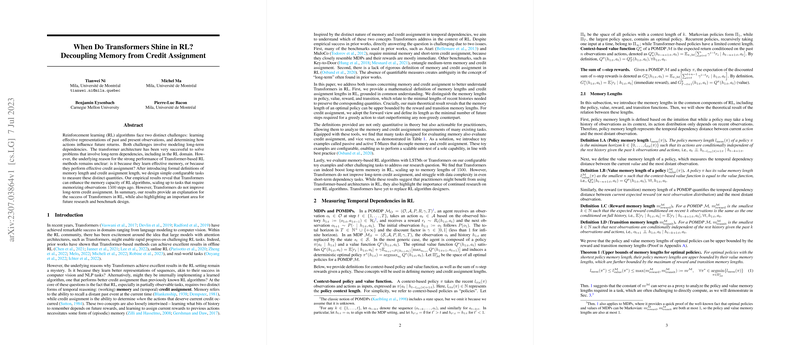Overview of "When Do Transformers Shine in RL? Decoupling Memory from Credit Assignment"
In the paper "When Do Transformers Shine in RL? Decoupling Memory from Credit Assignment," the authors explore the specific strengths of Transformer architectures within the context of reinforcement learning (RL). Two key challenges in RL—memory and credit assignment—are dissected to better understand the contributions of Transformers to RL tasks.
The paper provides a formal distinction between memory and credit assignment in RL tasks. Memory refers to the need for recalling past observations, while credit assignment involves linking past actions to future rewards. To quantify these, the authors introduce definitions for memory length and credit assignment length, assessing how these dimensions impact the effectiveness of Transformers.
Key Contributions
- Formal Definitions: The paper introduces mathematical definitions for memory and credit assignment lengths, based on components like reward, transition, policy, and value functions. These definitions help quantify the capabilities required by RL tasks and assess the performance of models.
- Sequential Evaluation Tasks: The research designs configurable tasks that explicitly separate memory from credit assignment. Active and passive T-Mazes are used to demonstrate scenarios where long-term memory or credit assignment is the bottleneck. These tasks reveal that Transformers, while effectively handling long-term memory dependencies up to 1500 steps, do not enhance long-term credit assignment.
- Empirical Evaluation: Experiments conducted on standard POMDP benchmarks show that while Transformers excel in tasks demanding substantial memory, they fall short in improving long-term credit assignment. This discrepancy highlights the intrinsic architectural strengths and limitations of Transformers.
- Implications for RL: The findings suggest that practitioners might benefit from employing Transformers in RL tasks emphasizing long-term memory. However, the limited improvement in credit assignment underscores the need for continued progress in RL algorithms.
Results and Insights
The empirical results highlight that Transformers significantly outperform LSTM-based models in tasks requiring extensive memory capabilities, particularly those with memory lengths up to 1500. However, when tasks demand sophisticated credit assignment, Transformers do not outperform their LSTM counterparts. This distinction is pivotal in guiding the application of Transformer architectures in suitable RL contexts, avoiding their use in scenarios where long-term credit assignment is paramount.
Such insights direct researchers toward optimizing Transformer use cases, designing RL tasks that better harness their strengths, and advancing other RL algorithms to complement these capabilities.
Implications and Future Directions
The theoretical and practical contributions of this paper have implications in designing RL environments and architecture evaluation benchmarks. By defining and isolating memory and credit assignment, the research allows for more targeted RL algorithm development. This work can inspire modifications in RL procedural framework, ensuring Transformers are employed where they have maximum impact.
Future developments could involve enhancing Transformers for better credit assignment or integrating them with other architectures to balance their respective strengths. This direction may lead to more robust RL models capable of handling complex, long-term dependent tasks across various domains.
In conclusion, the paper sets a foundation for understanding the nuanced roles of memory and credit assignment in RL, providing valuable perspectives for both current practices and future innovations.
